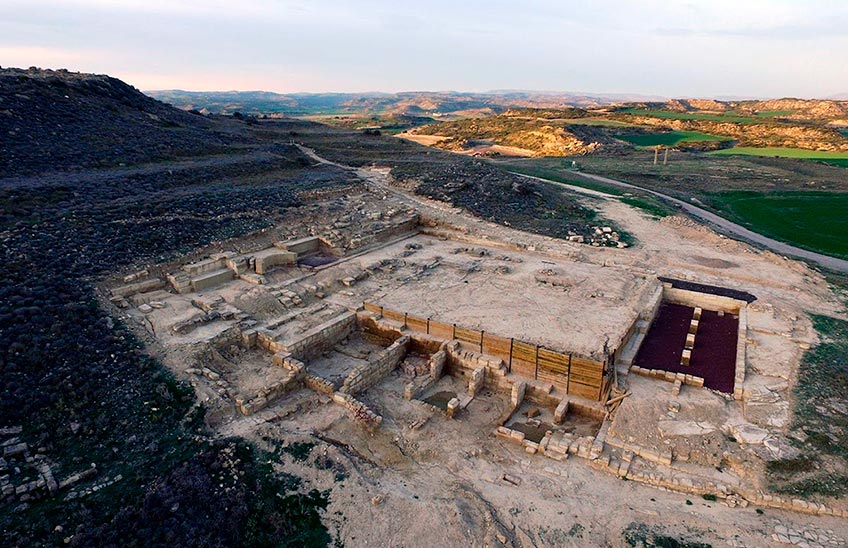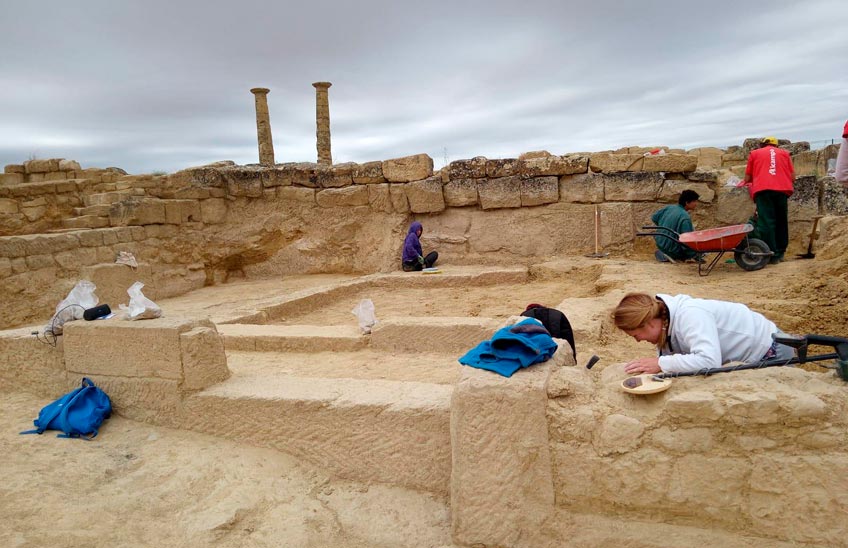Think
notebook Logbook: Los Bañales
A little less than a week ago, the fourteenth excavation campaign began at the archaeological site of Los Bañales (Aragón). Gabriel Garza Algaba, student of Degree in History + Diploma in Archaeology and Degree in Philology Hispánica, tells us in this last publication of the academic year 2021/2022 about his experience staff last summer. In September we will be back with new articles. We look forward to seeing you!

Located a few kilometres from the small village of Layana and forming part of the municipality of Uncastillo, Los Bañales stands as the main Roman enclave in Cinco Villas. Although it has been excavated since the 1940s, it has been thanks to Professor Andreu's work that it has been possible to establish a lasting excavation. Last summer was the thirteenth excavation campaign under his command; all of them uninterrupted, making him the archaeologist who has excavated Los Bañales the most. Throughout these campaigns he has been able to excavate: the forum, where the greatest discoveries have been made at the site, the artisan area, the basilica, among other areas. The excavation team is focusing on a domestic area, specifically on the area located around the two columns which, together with the baths and the aqueduct, from their withdrawal, were the most visible elements of the bequest of Rome in this city.
Every morning, workshop started at 6:30 and finished at 13:00. At Los Bañales we had a break in the middle of workshop; specifically, at 10:30. The weather at this site tends to be not very variable, with a predominance of extreme heat. And yet, contrary to predictions, the first week of excavation turned out to be bitterly cold, so much so that some of us had to go out and buy winter clothes. Every day we had to make a 15-minute drive to the site. This greatly slowed down all the archaeological work, but made every movement a spectacle. The morning workshop ended with lunch, which was prepared for us in the village restaurant. Being able to eat for two weeks without having to worry about making it yourself is a luxury. The menu was adapted to all tastes and diets. Vegans, for example, were very well looked after by the chef at the time. This is an element that I always like to highlight in every excavation, as I have been on one where they were given a very poor per diem expenses , being really discriminated against because of their dietary condition.
After fill in lunch, the evening workshop continued with the work of laboratory. At Los Bañales, the work of the laboratory was carried out periodically. This consisted of cleaning and classifying the finds extracted at each workshop excavation. In fact, we only worked on ceramic remains, as other more sophisticated cleaning techniques were required for bone, metal and pictorial remains.

The excavation was divided into four sectors; for each sector, a group of volunteers was assigned. During the two weeks of excavation, I had to work side by side with the group of archaeologists of the excavation. During the first week we had to find, by means of small probes [1 meter x meter pits], and excavate the management assistant wall that delimited the city. In my group was the excavator, a machine that used to patrol the entire site, removing as much work as possible. Thanks to it, we were able to extract more than ten meters of wall very quickly. However, the task was not easy, as we were immersed in a trench of more than one meter. Once the machine had extracted as much earth as possible, we removed the rest to clean the ashlars. Once the entire wall had been excavated, we proceeded to make several soundings about 30-40 meters perpendicular to the last ashlar found. Unfortunately we had no luck and we did not find the continuation of the wall.
I have had the good fortune to be able to excavate for the third consecutive year at this site and once again I can certify that the best thing about this site is two things. The first is the fact of living every day at the limit. Year after year, Los Bañales continues to show me that it is a place where things are always happening. Archaeologically, this site welcomes you with everything you can imagine: from coins, an amulet or a bell... While culturally, the excavation always gives you nice surprises. The walk to discover the enigmas of those small villages, or all the impressive excursions that Professor Andreu always has prepared. Excursions that, even if they are not obligatory, are always obligatory for oneself because if you don't know that you will miss very interesting things; like going to Huesca, to Trasmoz, the only excommunicated and cursed village in Spain, or visiting Borja and its Ecce Homo... As if this were not enough, to all this, we must add all the night excursions that we made, which gave a great anecdote to the excavation experience. The second aspect is the people. Maybe it is the intensity, or the fatigue, but what is clear is that every year I take a very large group of people with me. An unforgettable experience.
If you liked the article, you might be interested in one of our Degrees!









